Meet Mailbird, My Once Favorite Windows Email Client
As someone who's always on the lookout for efficient email clients that would pair well with my main inbox management tool, Clean Email, I was thrilled when I first discovered Mailbird shortly after its initial beta release, which happened in 2013.
Back then, there weren't many well-designed free email clients for Windows (and MacOS soon), and most people were using either Microsoft Outlook or Mozilla Thunderbird. I wanted something sleeker, something that would make the time I have to spend dealing with emails more bearable.
Inspired by the Sparrow email client for Mac, Mailbird offered me and other Windows users a lightweight yet powerful alternative to existing email clients that I instantly fell in love with. More than a decade has passed since the initial release, and Mailbird, now in version 3.0, is more polished and capable than ever before.

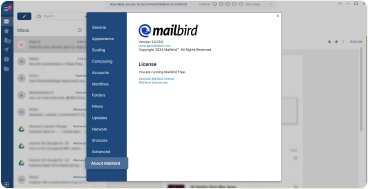
- Easily manage several email accounts from a unified inbox.
- Customize the user interface to your preferences.
- Email templates and (soon) AI-powered replies.
- Useful inbox management features.
- Seamless integration of many popular apps.
- The company doesn't honor old licenses.
- Limited functionality in the free version.
- Less capable inbox management tools compared to specialized solutions like Clean Email.
Mailbird's User-Friendly Design
Mailbird shines as one of the best email clients for Windows 10 and 11 because a lot of thought has been put into its user interface (UI) design. Having excelled on Windows for years, we're excitedly awaiting the macOS version, which promises to deliver the same level of innovation and functionality to a new audience.
On the left, you'll find a sleek sidebar hosting your email accounts and folders. The middle pane displays your message list, offering a quick overview of your emails with customizable preview options. To the right, a spacious reading pane allows you to view and interact with your emails without constantly opening new windows.
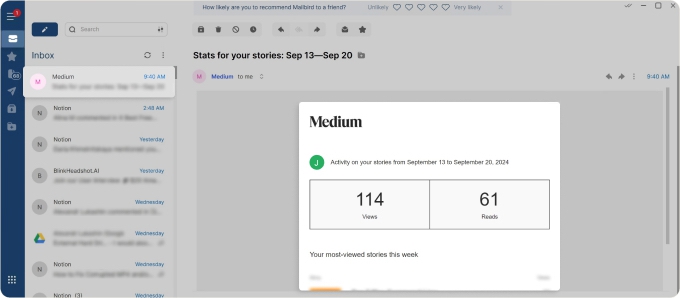
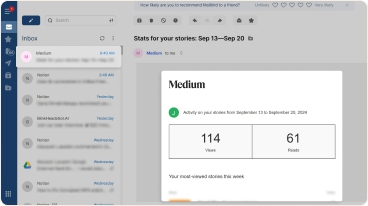
The latest version of Mailbird features a clean, modern aesthetic with updated fonts and soothing color palettes that are easy on the eyes during long email sessions. The streamlined navigation and optimized screen space contribute to a clutter-free environment that allows you to focus on your messages without distractions.
Mailbird for Mac Release
After years of being available exclusively for Windows users, Mailbird is now expanding its reach to macOS with the release of Mailbird for Mac in October 2024.
Mailbird for Mac brings the same powerful features as the Windows version, including a unified inbox, custom integrations, and productivity-enhancing tools such as email tracking and advanced email signatures.
Existing users with a Mailbird 3.0 license can now use their key to activate the app, while new users can take advantage of a special Early Access discount.
Loaded with Features
Mailbird is packed with features designed to improve email organization. If you have, like I do, multiple mail accounts, then you can add them all to Mailbird and access them from a single, unified inbox or switch between them with ease (keyboard shortcuts are extensively supported).
Customization is at the heart of Mailbird's design philosophy, and you can change not only how the client looks, but also how it sounds. That said, the default settings are great in my opinion, so it's not like you have to spend a lot of time tinkering with different settings just to make Mailbird usable.

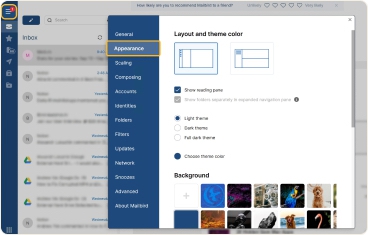
For faster email composition, Mailbird offers email templates. With their help, you can quickly insert pre-written text for common responses and save time and effort. I'm also excited about the upcoming AI-powered email authoring feature, which promises to conquer writer's block and generate human-like responses in seconds.
When it comes to inbox management, Mailbird includes several useful tools to help you organize messages like a pro. With message snoozing, you can temporarily remove non-urgent emails from inbox, the sender blocking feature helps keep spam at bay, and Mailbird filters can automate commonly performed actions. Sure, these features are not as well-thought-out as their counterparts in a dedicated tool like Clean Email, but it's still nice to have them right in the email client.
Mailbird also shines when it comes to app integration. You can easily access various apps like email accounts, calendars, to-do lists, and more, all from one interface without switching tabs. Simply click the Apps icon in the bottom left corner, browse through available apps, or even add custom ones using the + Custom app button.
Overall, Mailbird would easily still be my favorite email software in 2026 if usability and features were the only things that mattered.
Mailbird Security and Privacy
One of the key features I appreciate is that Mailbird operates as a local client on your computer, meaning all sensitive data is stored only on your device. This alone significantly reduces the risk of unauthorized access to your emails.
Whenever data is transmitted between your Mailbird client and a remote server, such as when downloading messages or checking your license key, the connection is encrypted, so no third parties can intercept or read your data.
While Mailbird does collect some user data for improvement purposes, such as feature usage statistics, they've been transparent about their practices. Users have the option to opt out of data collection, which I find commendable.
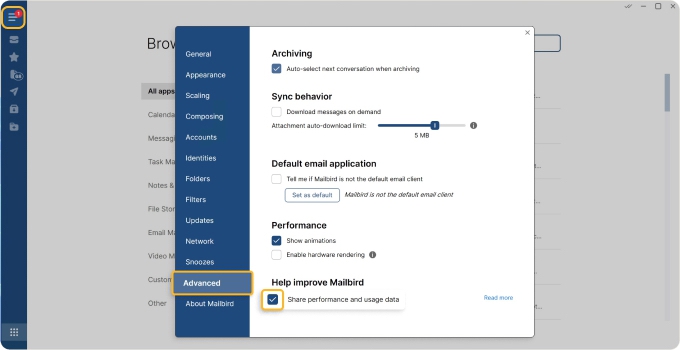
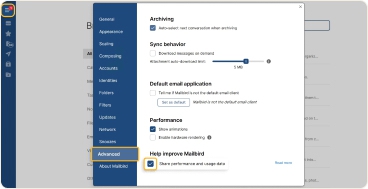
However, if you're looking for the most secure email experience possible, you might want to consider combining Mailbird with one of the best free private email providers for an extra layer of protection.
Deceitful Pricing
When it comes to pricing, my Mailbird review takes a critical turn. The current pricing structure for Mailbird is as follows, with yearly fees:
- Standard Pay Once: $49.50 per user (+ $10.00 per year for Lifetime Updates)
- Premium Pay Once: $99.75 per user (+ $20.00 per year for Lifetime Updates)

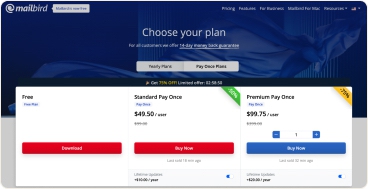
At first glance, these prices might seem reasonable for a feature-rich email client. However, my experience with Mailbird's pricing practices has left me wary. Even with the "Lifetime Updates" option, I don't trust Mailbird not to charge me again when they release version 4.0.
You see, I purchased a lifetime license in the past, but that license stopped working when version 3.0 was released. This practice has understandably upset many users. As one Reddit user put it:
It's worth noting that Mailbird does offer a free version, but it's severely limited. You can only use it with one email account, and it lacks many useful features, including email templates, the block sender feature, ChatGPT integration, and more.
Furthermore, with the recent release of Mailbird for Mac, it's important to mention that the same pricing model applies to macOS. If you plan to use Mailbird on a Mac, you will need to purchase a Mailbird 3.0 license, and there's no guarantee that lifetime licenses from previous versions will carry over to future updates.
If you need to access only a single account on a Windows computer (like I do now that macOS is my main operating system), then Mailbird isn't a bad choice—I just personally wouldn't pay for its premium features again and, instead, would declutter my inbox using Clean Email.
Why I Rely on Clean Email for Inbox Management
Clean Email has been a lifesaver for me, especially since Mailbird’s free version is limited to just one account and lacks features like sender blocking. Having used the same mailbox for years, I rely on Clean Email to keep it manageable. It’s a great companion to Mailbird, filling in the gaps where the email client falls short.
With Clean Email, I can block unwanted senders and use features like Auto Clean, Cleaning Suggestions, and Unsubscriber to keep my inbox organized without much effort.
Auto Clean
The Auto Clean feature allows me to automate actions like archiving, deleting, or moving emails based on criteria I set.
For example, I’ve created rules to automatically delete old, unread promotional emails larger than 1 MB, meaning they contain images or other attachments that take up storage space. Now, this automation saves me a lot of time and keeps my inbox clutter-free without manual cleanups.
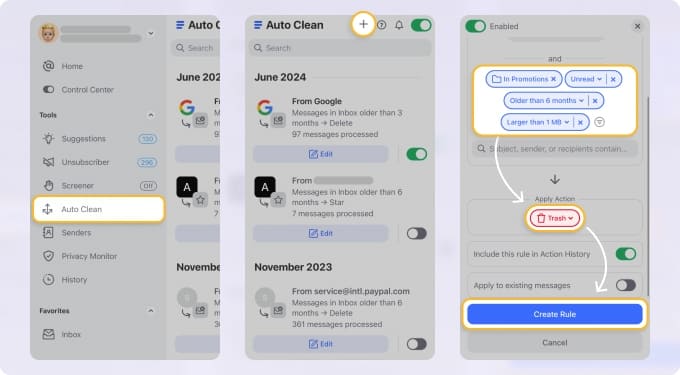

Cleaning Suggestions
The Cleaning Suggestions feature is another tool I rely on regularly. Clean Email intelligently analyzes my inbox and provides recommendations for actions like unsubscribing from newsletters I no longer open, or grouping similar emails for bulk actions such as moving to Trash or archiving.
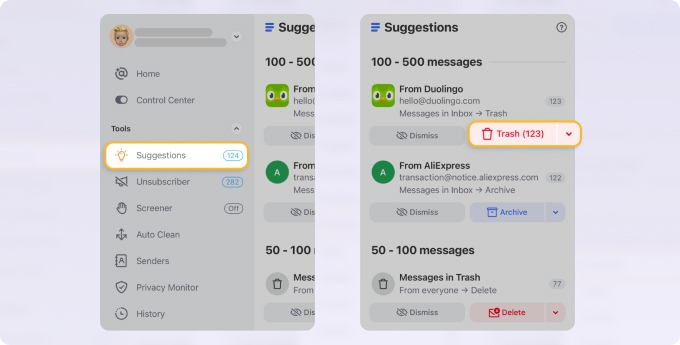
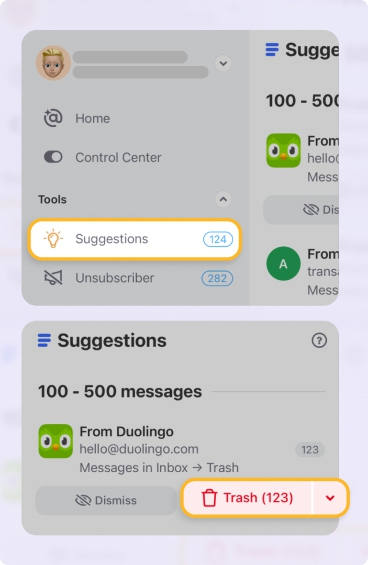
Unsubscriber
The Unsubscriber feature is invaluable for getting rid of unwanted newsletters and promotional emails that tend to pile up. With just a few clicks, I can unsubscribe from emails I no longer want to receive, helping me reduce inbox overload and stay focused on important messages. It's quick, effective, and has significantly reduced the number of distractions in my inbox.

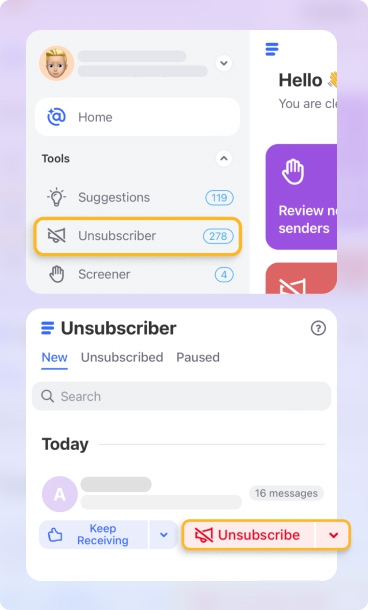
And there’s more!
Another thing I love is that I can add multiple accounts to Clean Email, which is perfect for someone like me who has several inboxes to manage. The Clean Email app works seamlessly with all major providers, so I can control different accounts in one place.
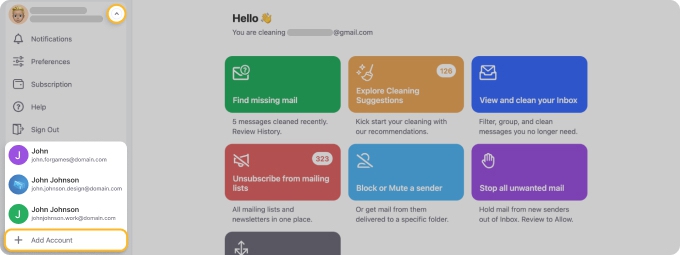
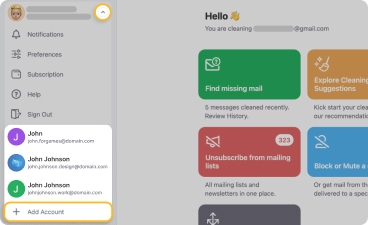
As I’ve started using my Windows computer less and relying more on my phone over the years, Clean Email has been a huge help in managing my inbox on the go. I love that I can access Clean Email not just from my desktop, but also on mobile.
For users who want to take advantage of this, Clean Email is accessible both on Android and iPhone, offering the same powerful features across devices.
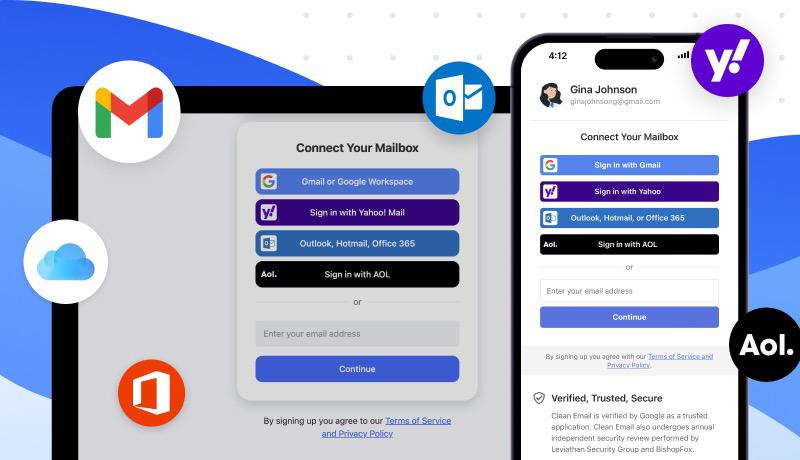
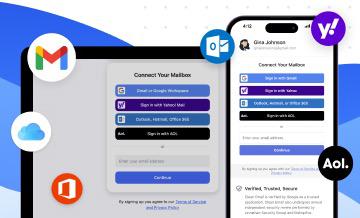
Verdict
I find myself in a conflicted position. On one hand, Mailbird offers a sleek, feature-rich experience that can significantly streamline email management for Windows and macOS users. Its user-friendly design, customization options, and innovative features like AI-powered email authoring are certainly impressive.
However, the company's questionable pricing practices and handling of "lifetime" licenses have severely diminished my trust. My recommendation is to give the free version a try (it's really good!) but think twice before you purchase a Mailbird license.


